Salento – Introduction to the Colombian Countryside
This is my seventh post from the country of Colombia and the first outside the environs of the capitol city of Bogota. Our Adventures Abroad group spent an amazing two days in Bogota, so much so that I was able to generate six different posts on just our time there. You can read them here starting with this post on the flower market. However, it is now time to venture into the Colombian countryside and see if the place is as safe and civilized as we found Bogota. Frankly, despite my extensive travels, I have very little knowledge of rural Latin America and am a blank slate waiting to have new experiences, good or bad, written upon it. Our initial destination is the small town of Salento in the heart of the Colombian coffee growing region. I hope you’ll come along for the journey.
Although, as the crow flies, Salento is only just over 100 miles from Bogota, it lies at the other side of one of the three spines of the Andes that pierce Colombia like a trident. For that reason it is a lot quicker to fly to the nearby city of Armenia and drive from there rather than cross the mountains. It’s the preferred way for most Colombians to get from city to city. So that’s what we do. The Avianca flight is just over 30 minutes and after getting up super early to catch this flight, we all stumble out onto the tarmac and into El Edén International Airport, blinking in the bright morning sunlight. Considering the airport is about as large as that at Flin Flon, I wonder where the international flights are coming from.
Believe it or not the luggage is on the belt before we walk into the airport. Air Canada, take note.
We have time for an improvised breakfast while waiting for our bus and I feed half of my huge croissant to a smiling dog who sticks his head through the open exit door, but won’t come through. He apparently knows the drill about begging in airports.
The bus arrives, we pile in and are on our way to Salento. We drive through the city of Armenia, which has about 300,00 residents and was actually renamed from Villa Holguin to Armenia in honour or protest of the massacre of Christian Armenians by the Ottoman Empire in the late 1890’s. The city’s eastern flank sits high above the gorge of the Quindío River and there is clearly a building boom of high rise apartments or condos that sit precipitously overlooking the gorge and the verdant landscape on the other side. They have million dollar views, but I can’t help think of the 1999 earthquake, with an epicentre close to Armenia, that devastated the city. I guess after the years of living dangerously, Colombians are a bit nonchalant about non-manmade disasters.
Salento is about a dozen kms. (8 miles) off Highway 29 on a narrow dead end road that descends down the Quindío River valley, over the river and then steeply up to sides of the valley on the other side. The scenery is remarkable and quite unlike any I have ever seen before. This is the heart of Colombian coffee growing country and although much of the land is given over to agriculture, much of it is still wild in appearance. As our bus pulls into the outskirts of Salento the streets get very narrow and our tour guide Andres Fernandez announces that our luggage will be transported to the hotel by way of Jeeps.
However, these are not just any Jeeps but Willys, the original maker of the classic WWII all purpose vehicle that became known colloquially as a ‘jeep’. Considering their age, (up to 60 + years old) the machines are in remarkable condition and distinguished by their many bright colours and different hood ornaments.
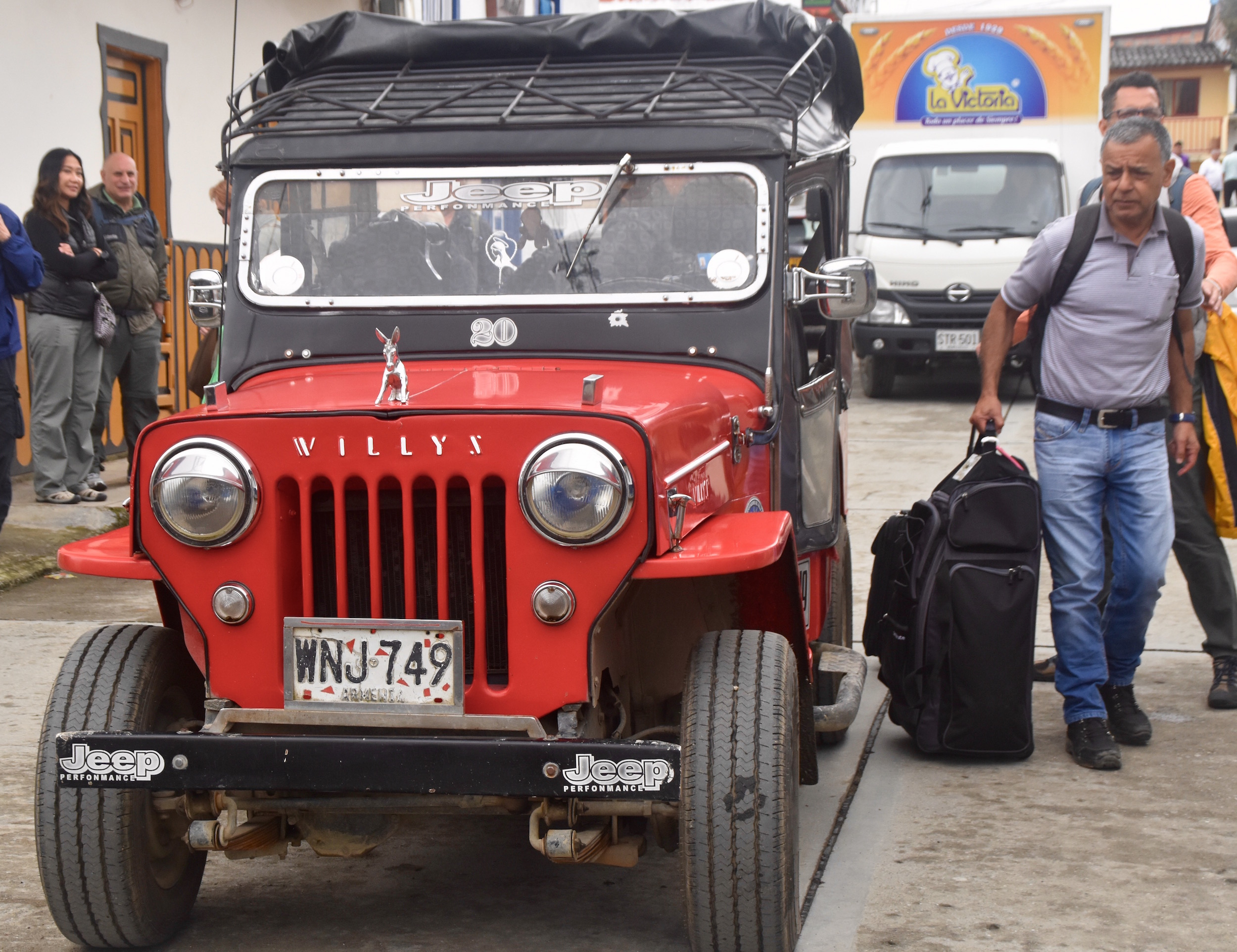
That’s our local guide George González helping load the luggage. After the luggage wagon leaves we follow George to our hotel a few blocks away. I immediately notice that Salento is apparently a haven for young backpackers as they are everywhere and every second place of accommodation seems to be a hostel and not a hotel. The area is well known for its hiking and horseback trails as well as a bevy of other outdoor sports like mountain biking and climbing. There is definitely an aura of youth about the place. Whenever one encounters this type of scene, once you’re well past the age of participating in it, like pretty well all of us on this Adventures Abroad trip, there can only be two possible reactions. The first is to indulge in a sort of self-pity that is really nothing more than jealousy at not being this young and vibrant like we all thought we once were. That is not helpful. The second is to enjoy the blast of brio, testosterone and bullshit and wish them well. That’s what I do.
Hotel Salento Real
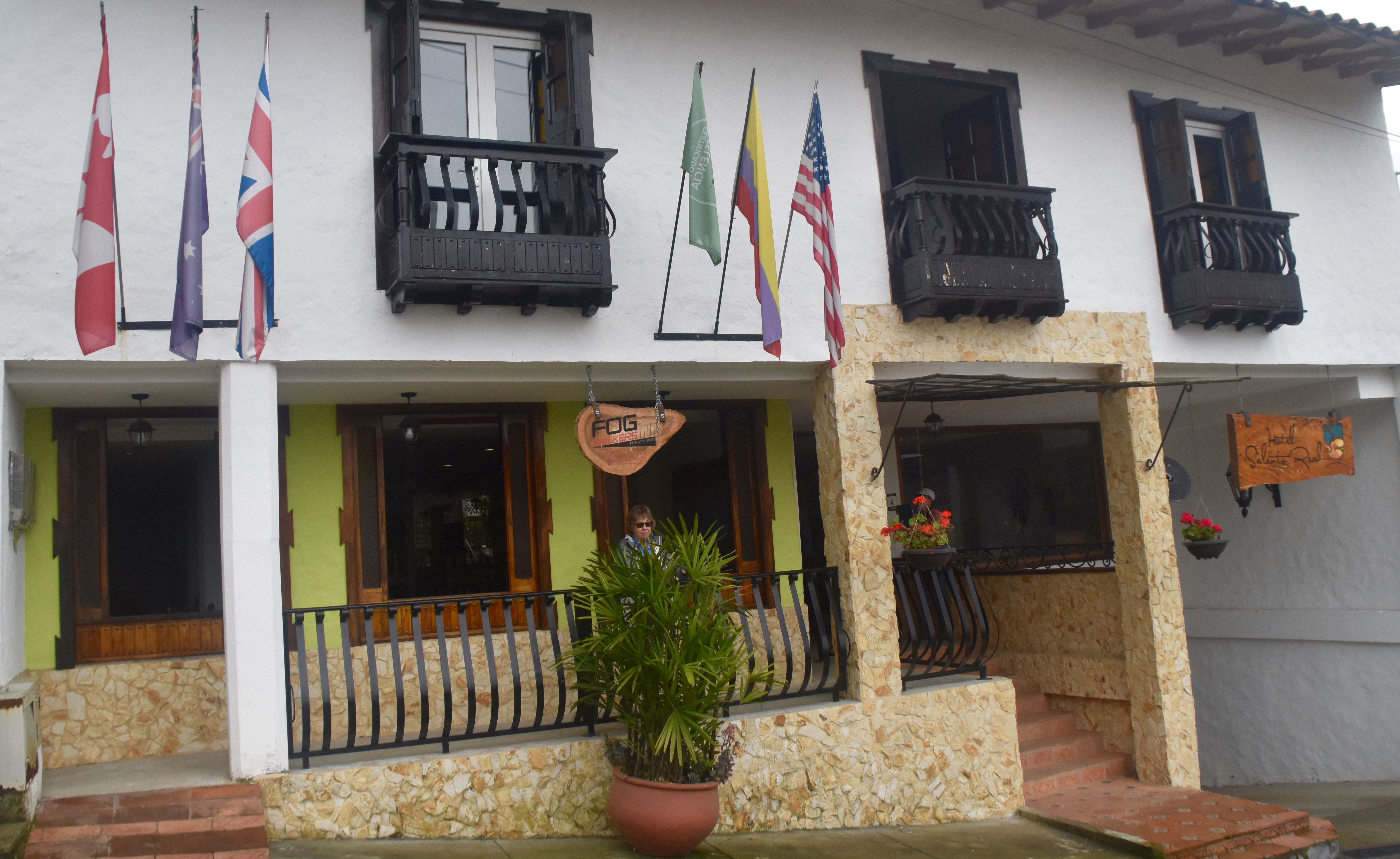
Our accommodation for the next two nights is the Hotel Salento Real which is just a block off the main street. This is as good a place as any to talk about what a fine establishment this is and why, after reading about it, you might want to stay here on a visit to Salento.
Adventures Abroad does a pretty good job of finding small family run hotels wherever possible and this is one. From the moment you walk by this mural near the front entrance you sense that it is different.
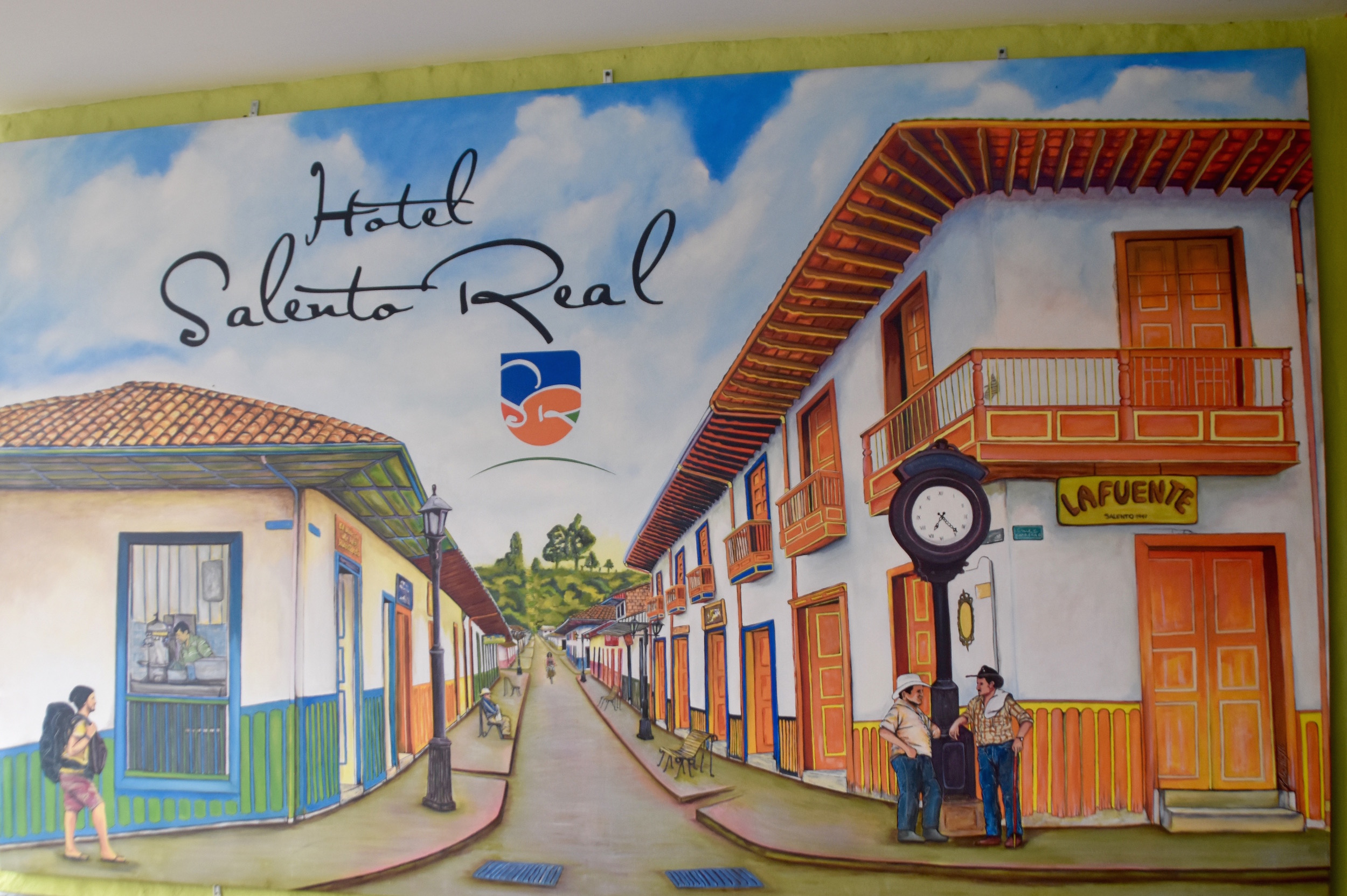
For starters there is local representative art everywhere. By representative I mean pictures of things you might expect to see in the Salento area like the mural above that perfectly captures the flavour of Salento’s uniquely painted exteriors. Other murals are painted on the interior walls like this one that does a far better job of illustrating the wonderful countryside around Salento than any photos I took.
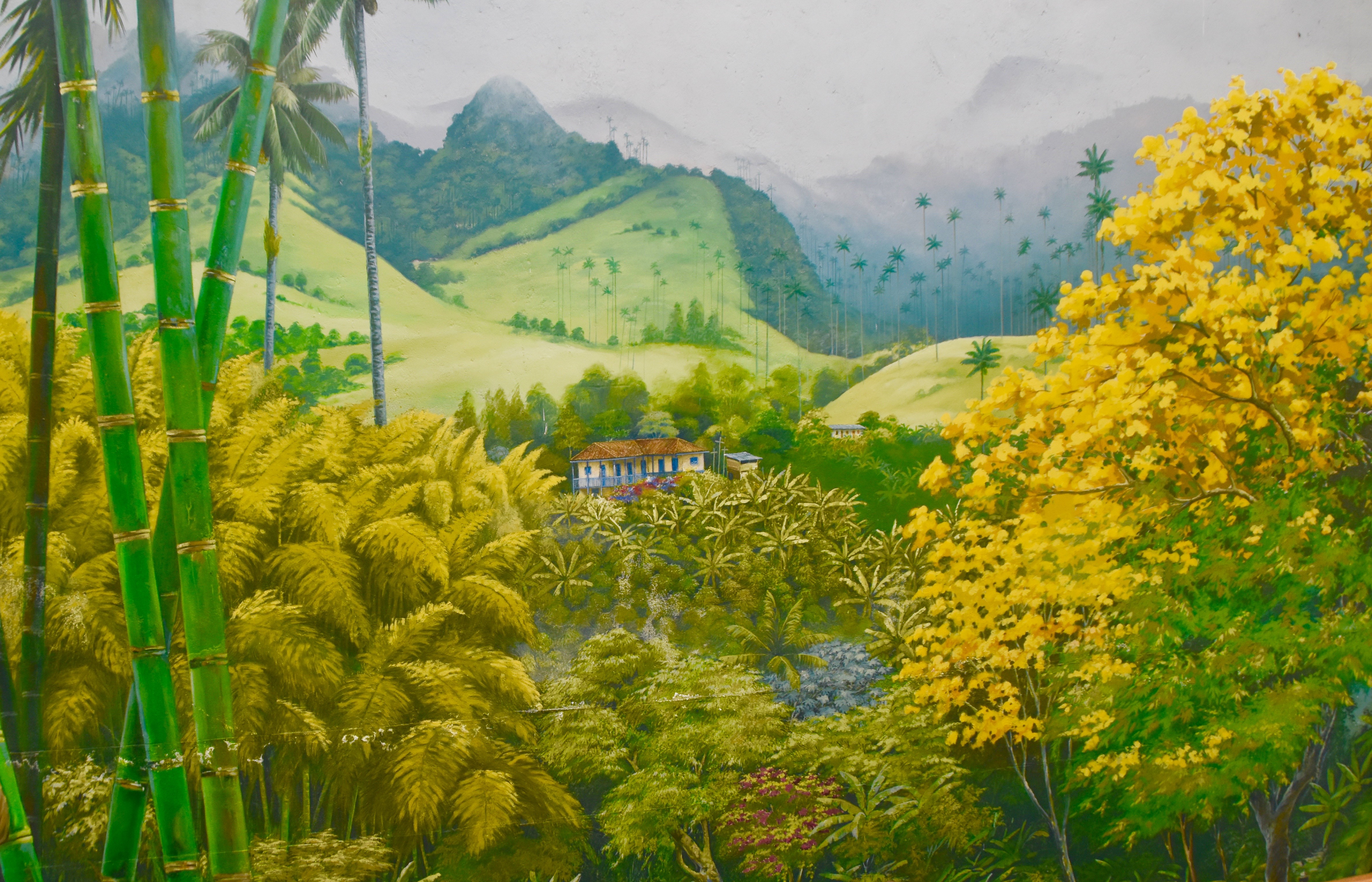
Or this one that incorporates the iconography of the Willys in Salento culture with the famed quetzal bird that features so prominently in so many Latin American mythologies. That’s the town of Salento in the background.
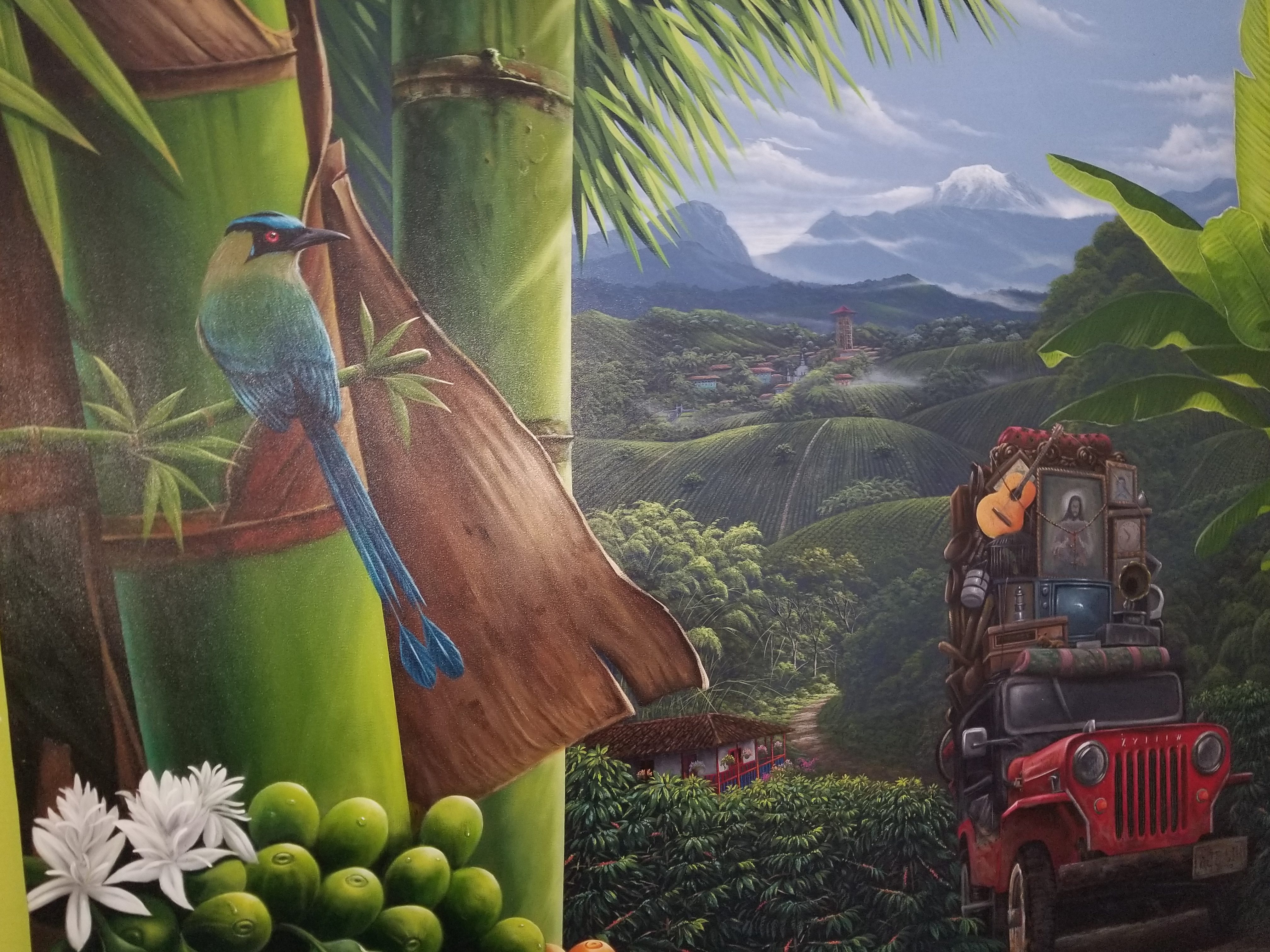
And then there’s this paean to Colombian coffee culture – that guy has to be Juan Valdez doesn’t he?
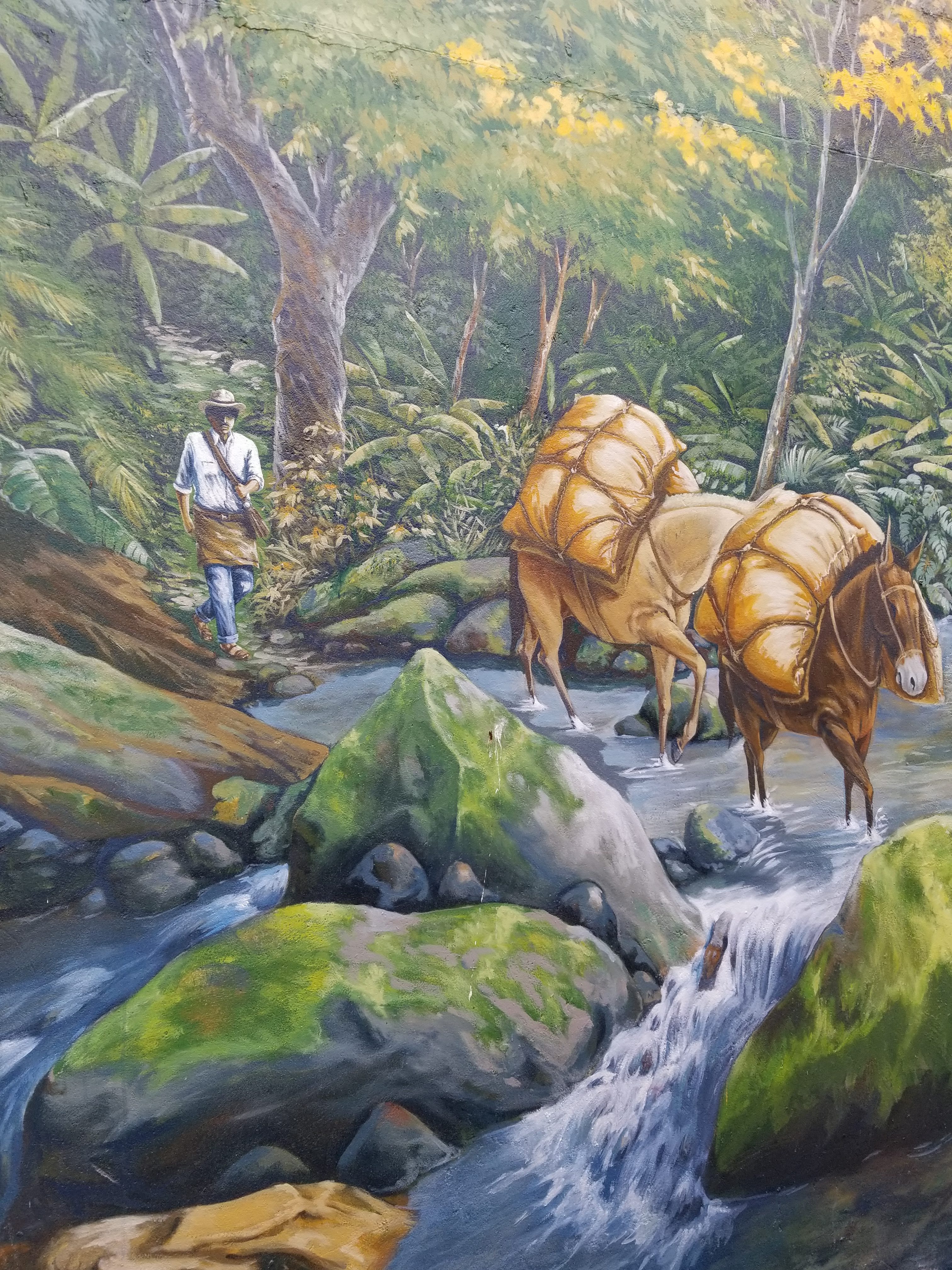
Aside from the murals there are some very good paintings that add further local colour to Hotel Salento Real like this one of the main plaza and church done in Van Gogh’s Starry Night style.
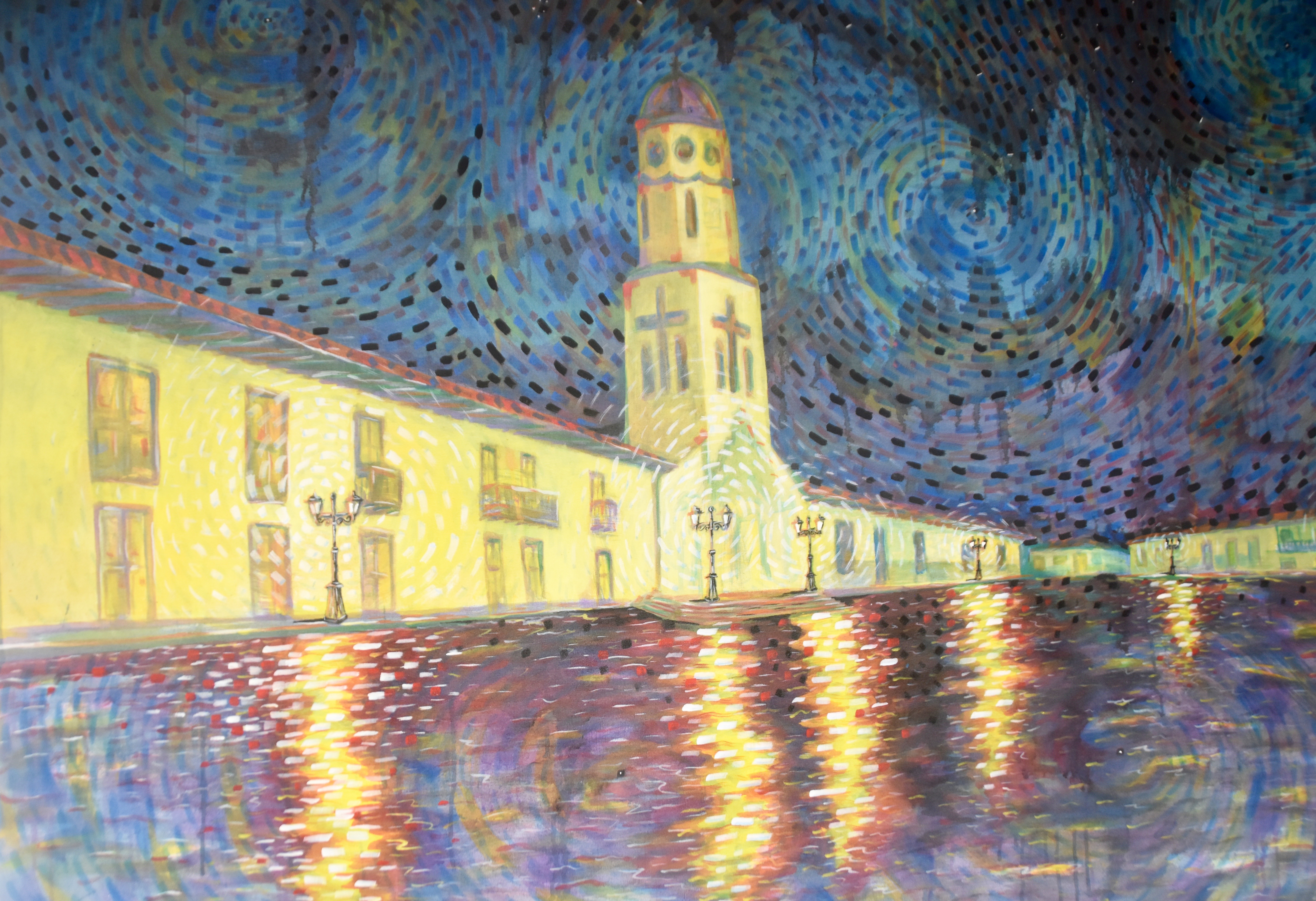
All this art work is placed around the sides of the airy central atrium that has two stories of rooms on each side.
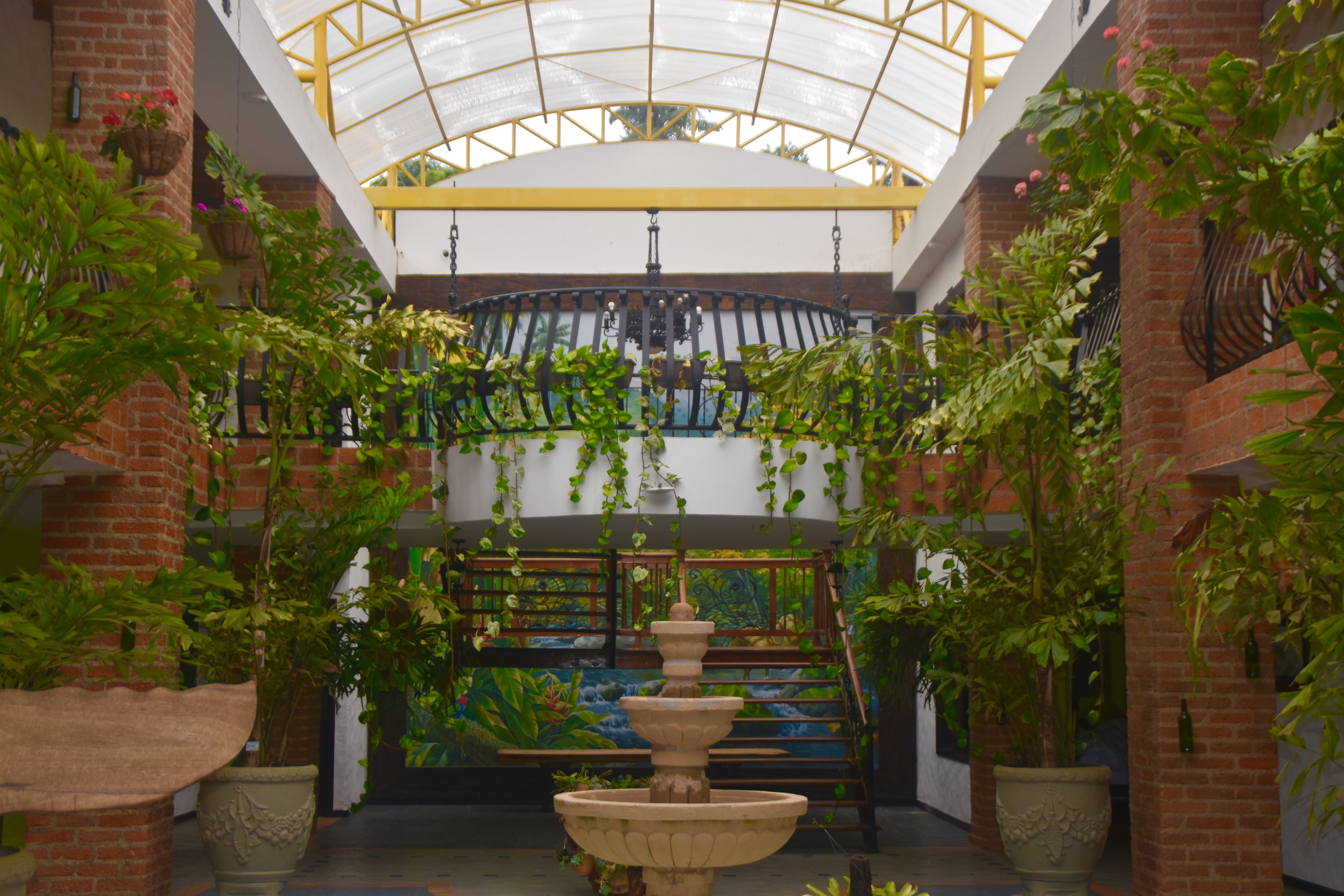
The rooms themselves at Salento Real are on the spartan side, but quite comfortable. If you need 500 thread count sheets and luxury toiletries then you shouldn’t be staying here; in fact, you probably shouldn’t be staying in Salento.
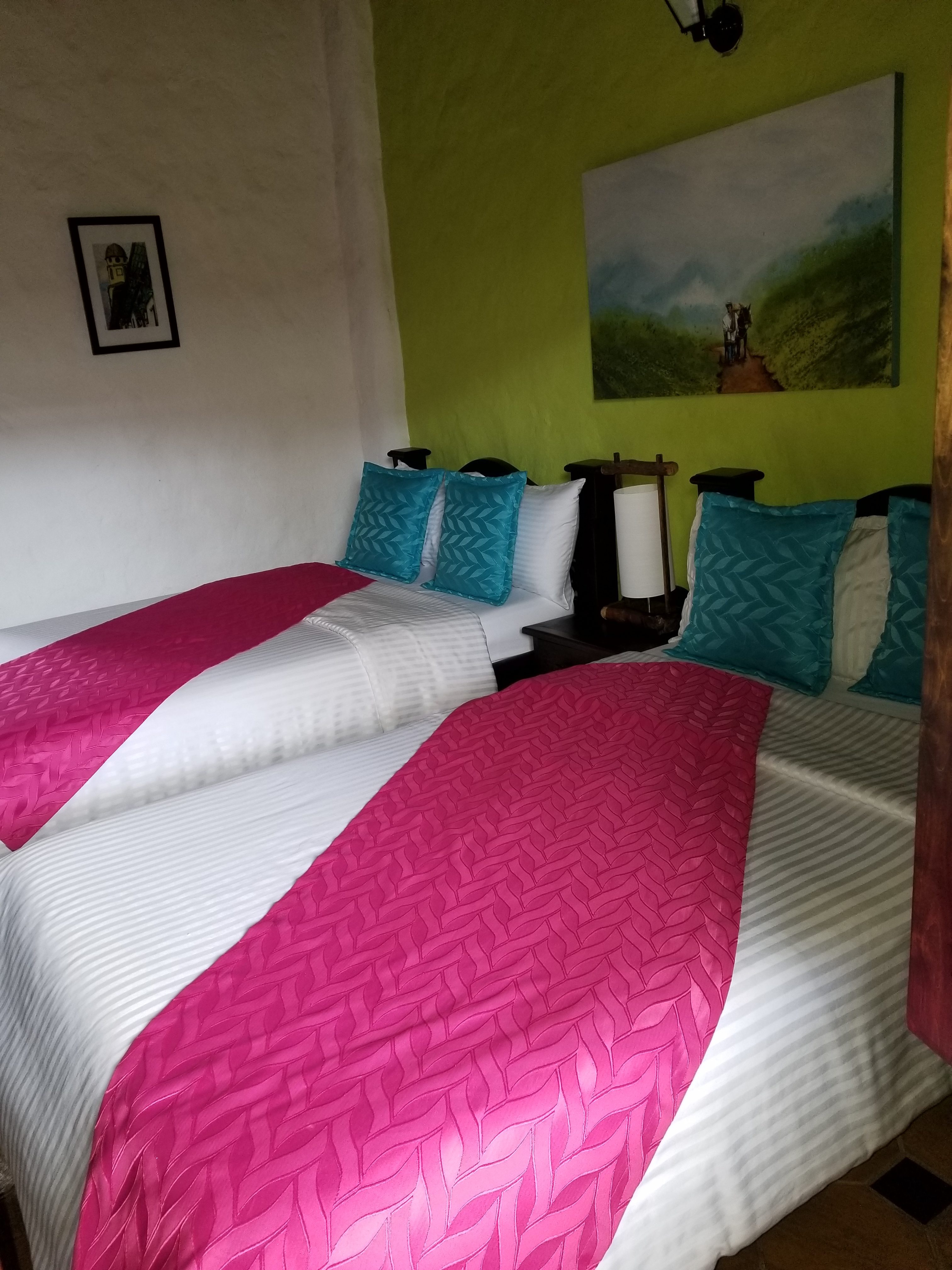
So, we really like Salento Real and now a bit more about the town.
History of Salento
Salento proper only has just over 3,500 residents and owes its popularity as a tourist destination to the fact that it got left behind, almost literally. It started with a pretty unique group of founding fathers in the mid-1800’s. The Guerra de los Supremos or War of the Supremes (and I’m not referring to Diana Ross’ issues with Mary Wilson) was one of those interminable South American disputes that followed on independence from Spain. After it was over, a bunch of political prisoners were sent to the area of modern day Salento to work on improving the road from Bogota to Popayán and after completing their sentences were granted land in the area, resulting eventually in the town of Salento. Then a good thing happened to Salento, although at the time I’m sure they thought it was a disaster – the main road was diverted to another location and Salento became a forgotten backwater. The result was that the 19th century wooden architecture that makes the town so appealing was preserved, life slowed down to a relaxed crawl and over a century later Salento was ‘rediscovered’ as a hidden gem. Today it’s a very popular weekend and holiday spot for Colombians as well as a worldwide attraction to youngsters who think they’ve discovered the next path to Shangri-La. I’m just glad I’m here.
Let’s explore the town.
The Mirador
After depositing our luggage in our rooms, George and Andres lead us up the steep streets of Salento towards the Mirador passing along the way this ancient Willys packed very much like the one in the mural at the hotel. It’s a tourist prop and for a $1 you can climb up and plant yourself, like Jed and Granny Clampett, on top for a photo. I opt instead to just zoom in and take this picture, ignoring the glare of the proprietor who was hoping for a quick buck.
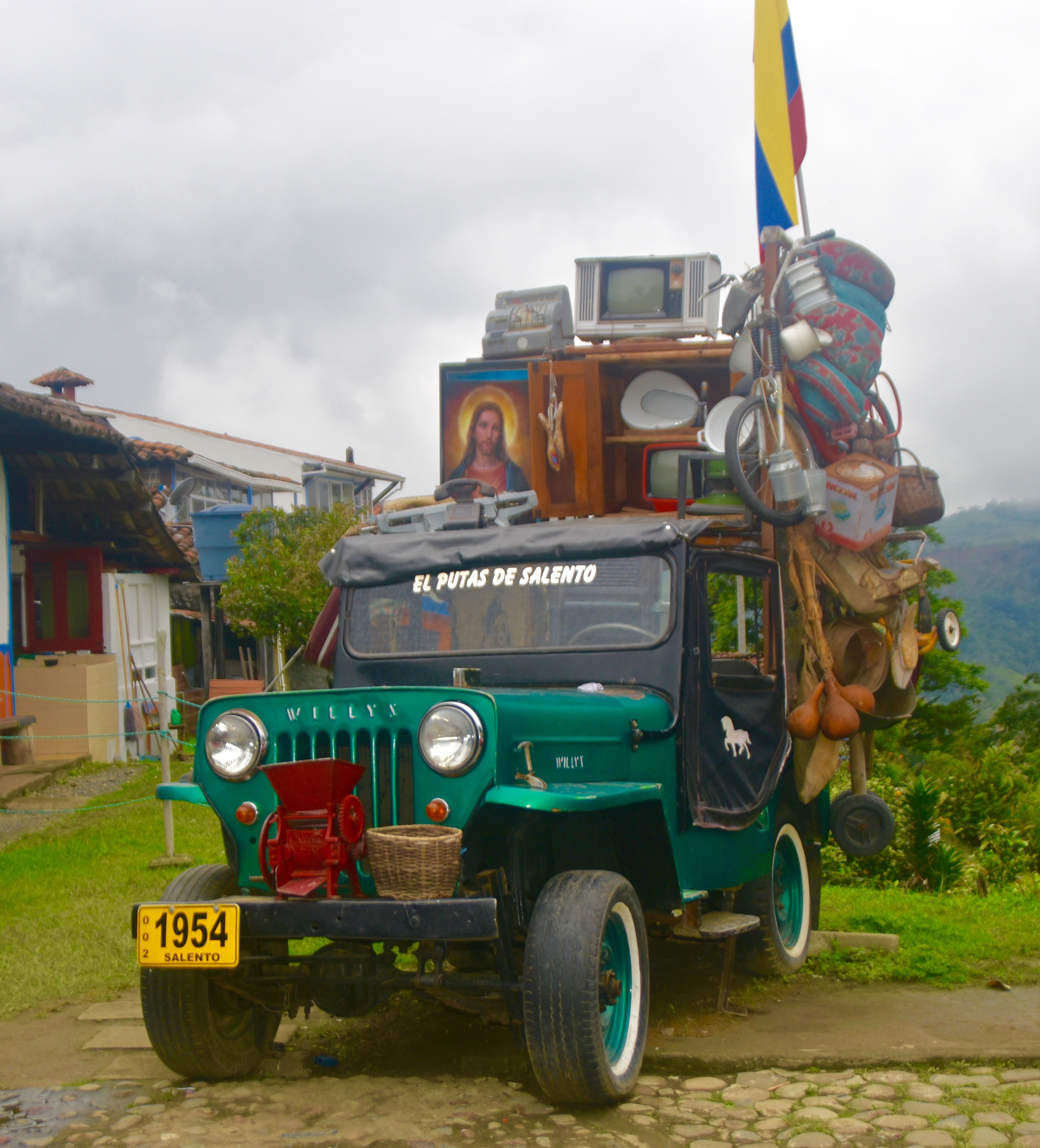
Every town or city should have a mirador, which is a pretty sounding word that technically means a balcony or window with a great view. Probably the most famous are those of the Alhambra palaces that overlook the city of Granada below. However, the term has long been used to describe any high place that has an outstanding panorama. This is Salento’s, first in a short video.
And then some photos in both directions.
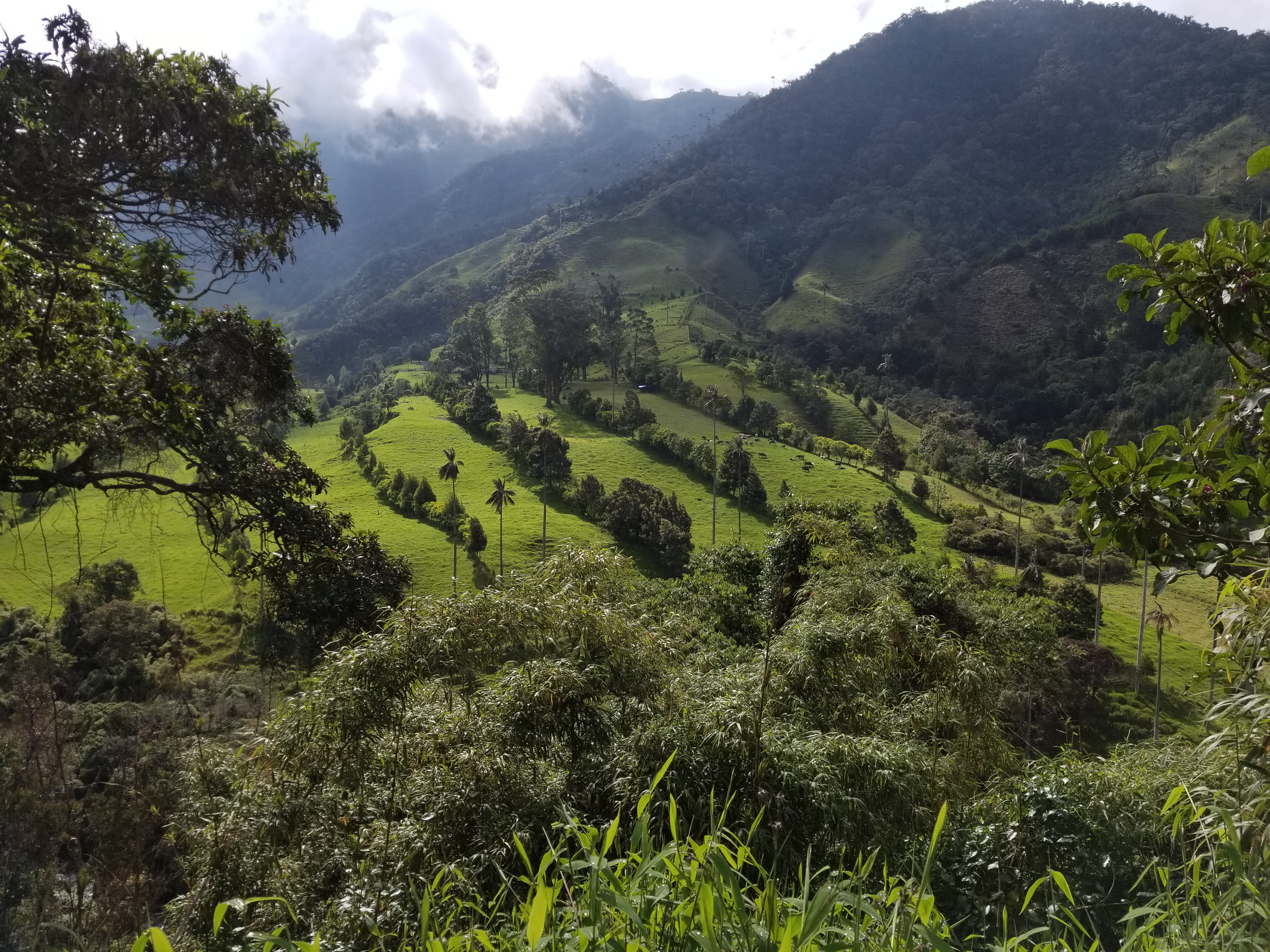
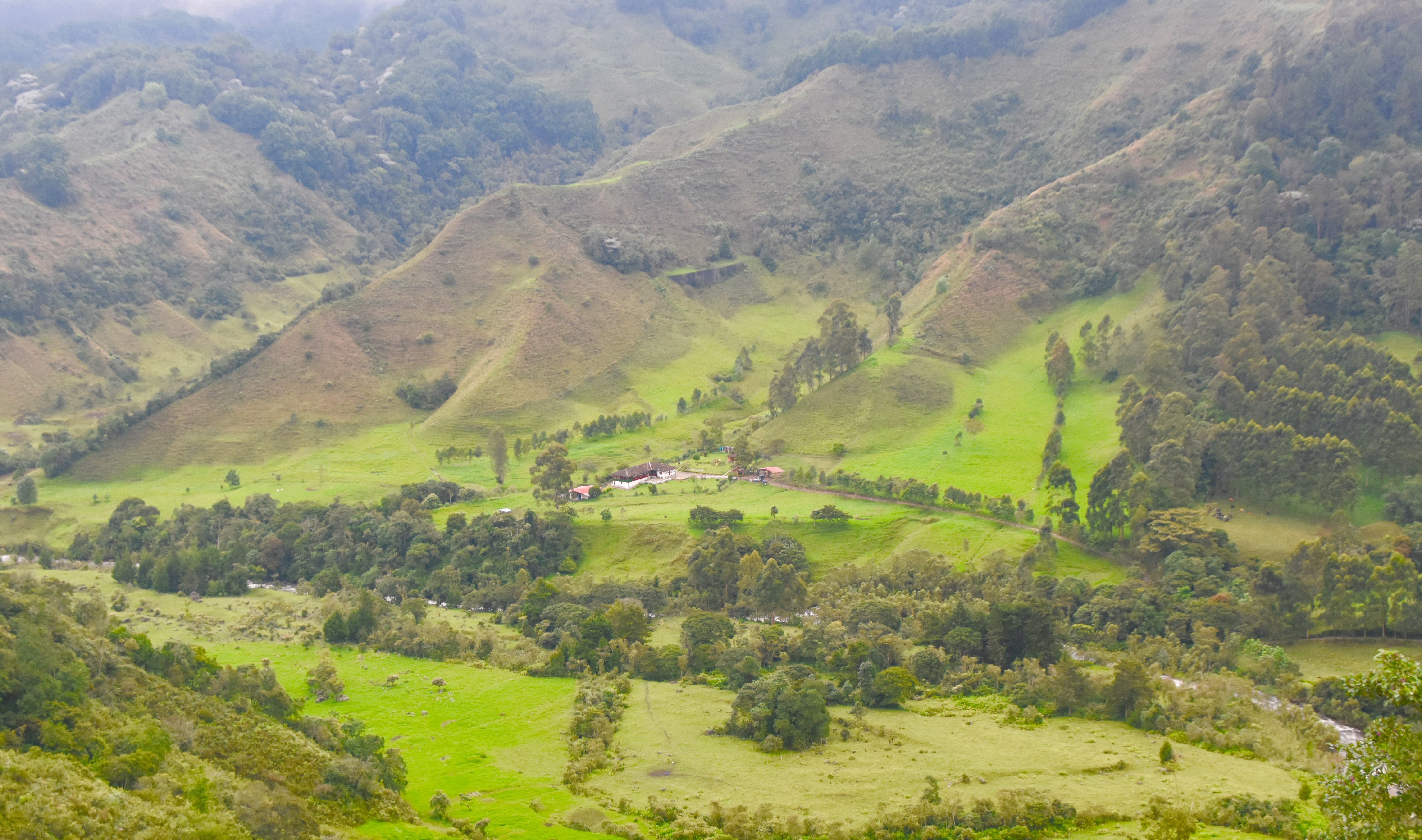
There is a second mirador close by from which you get this view of Salento. The street running down the middle of the photo is Calle Real, the principal street of the town and the church is Nuestra Señora del Carmen (Our Lady of Carmen) which fronts on the town plaza. That’s where we are headed next.
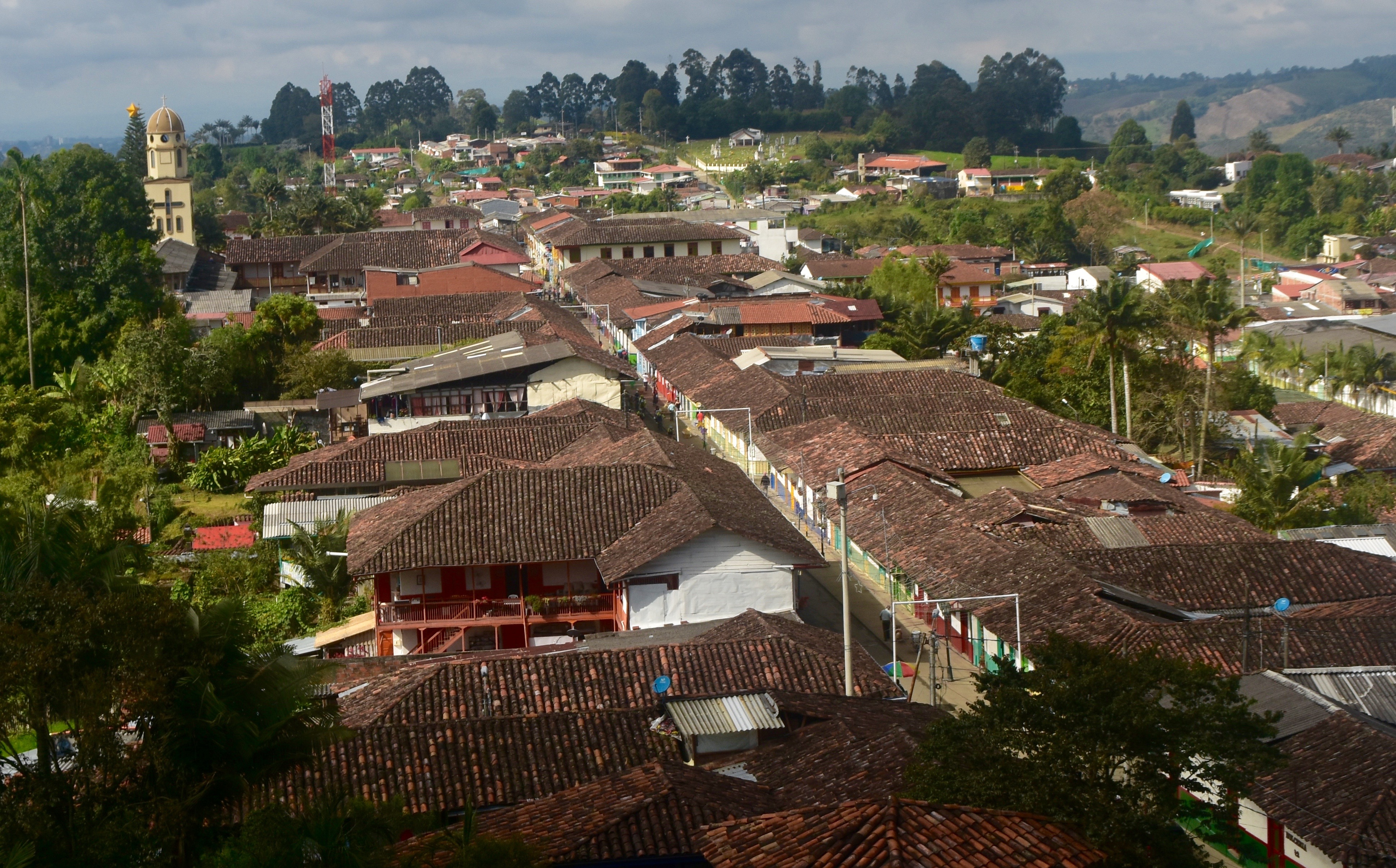
What really attracts tourists to Salento who are not young thrill seekers, are the brightly coloured wooden buildings that apparently are almost unique in Colombia. Walking down Calle Real towards the plaza reveals an amazing number and variety of these two story buildings. There can be little doubt that there is an ongoing competition among the owners to have the best and brightest facades which no doubt are helpful in attracting customers to the handicraft and souvenir shops as well as cafes that inhabit them. This is Calle Real, still with the Christmas decorations up.
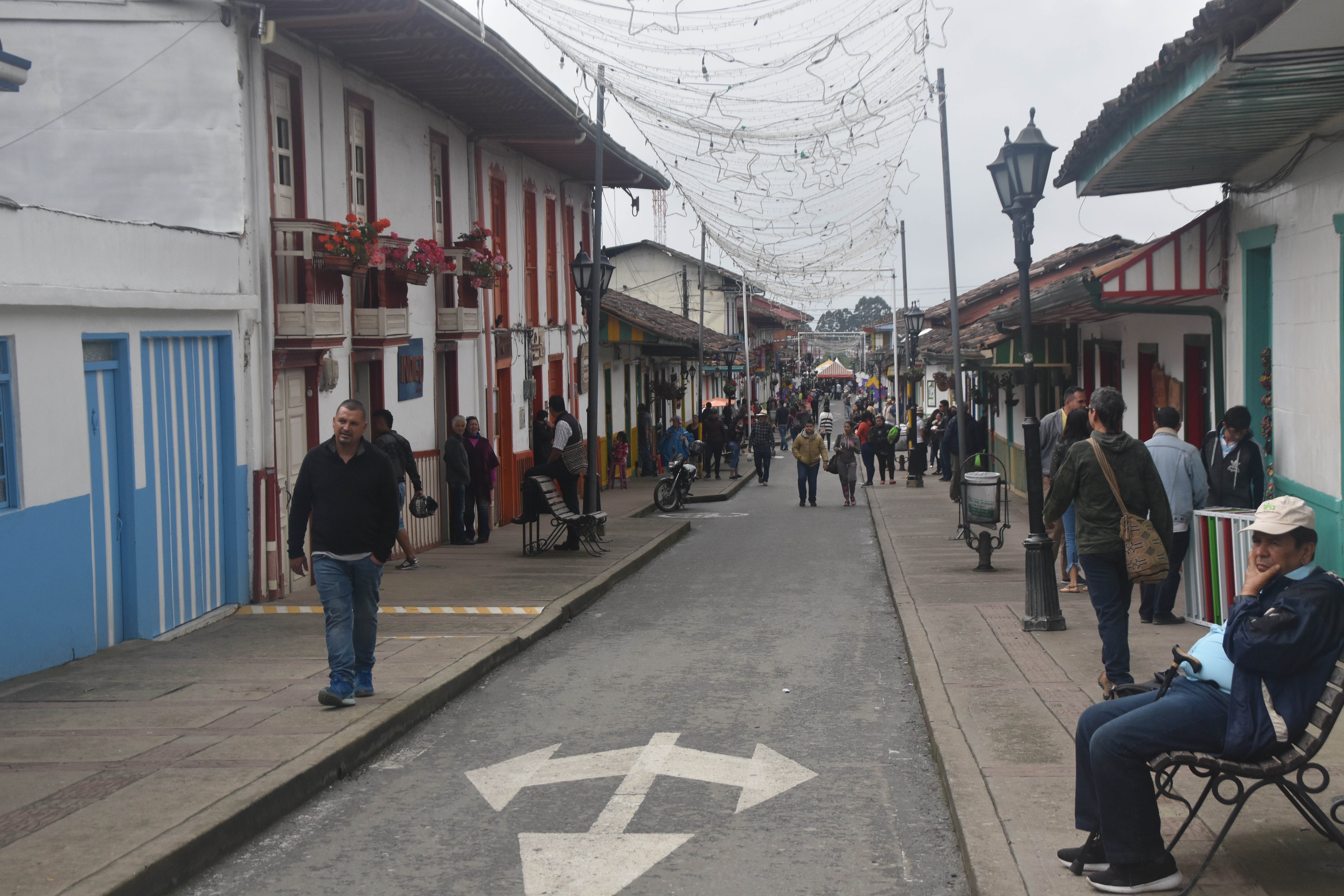
Here is a collection of photos I took on the first go round in Salento. One could do a photo essay just on these buildings, much as people love to do with the colourful doors of Georgian Dublin. This door is locked three ways to Sunday.
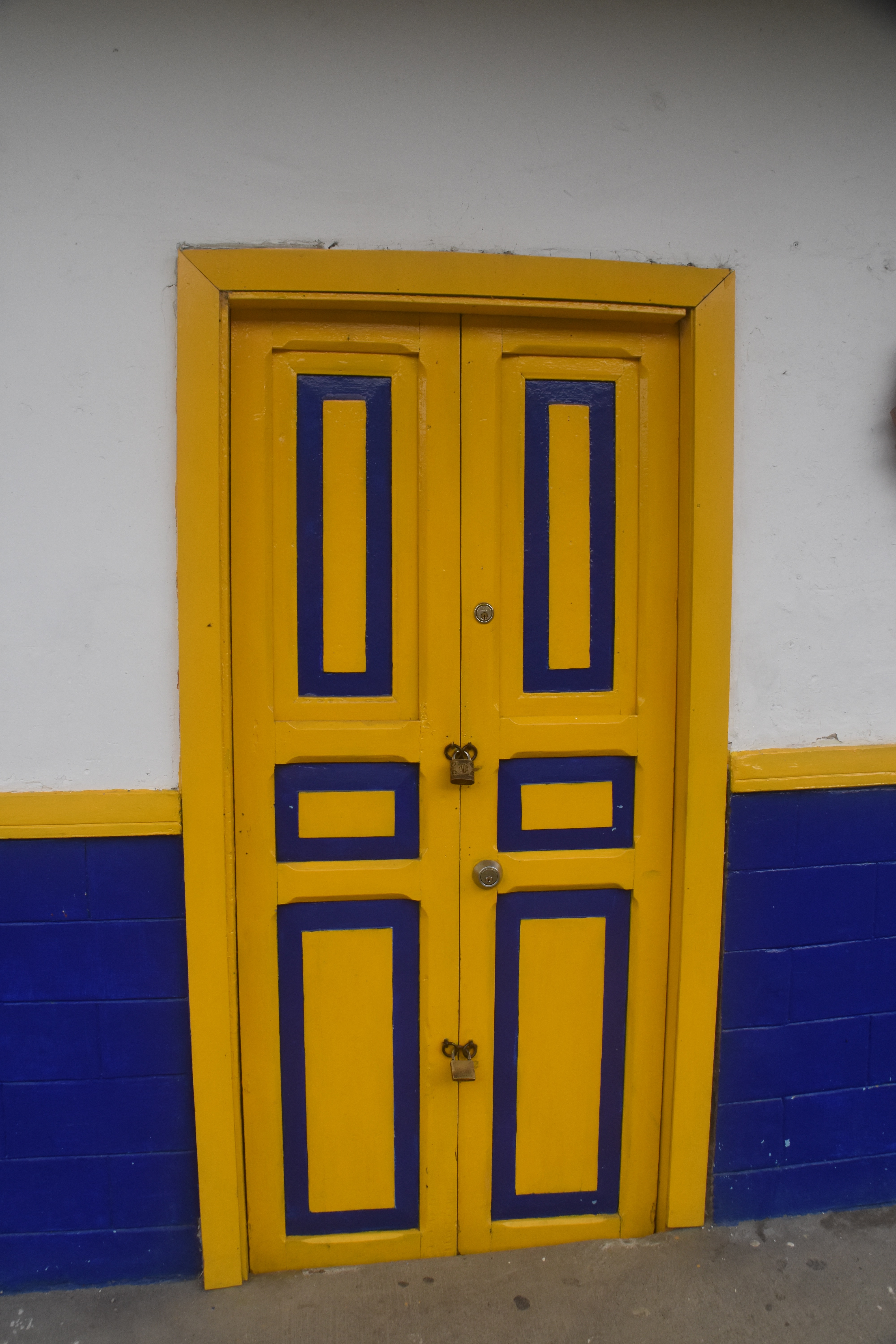
The second stories are often more interesting than the first.
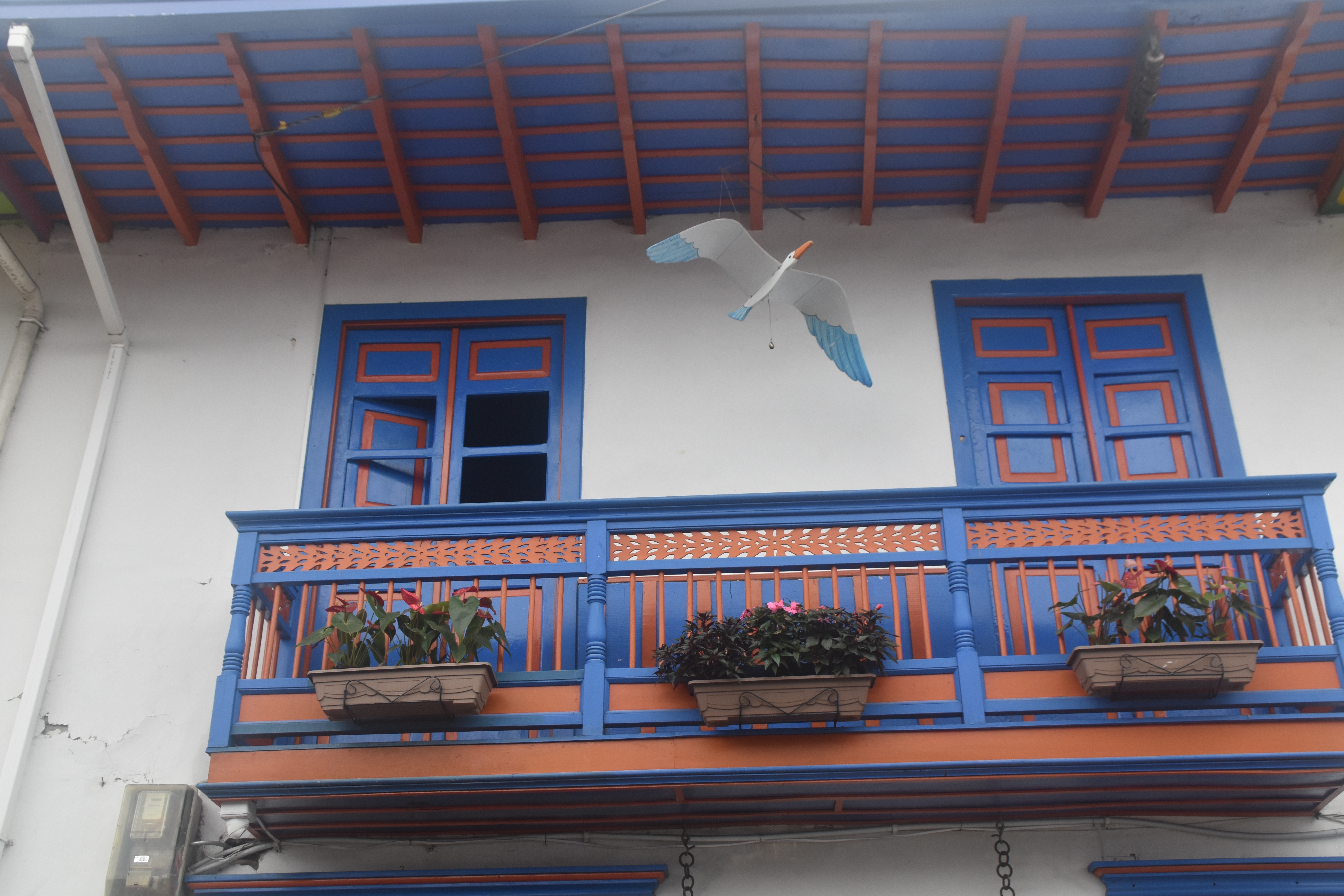
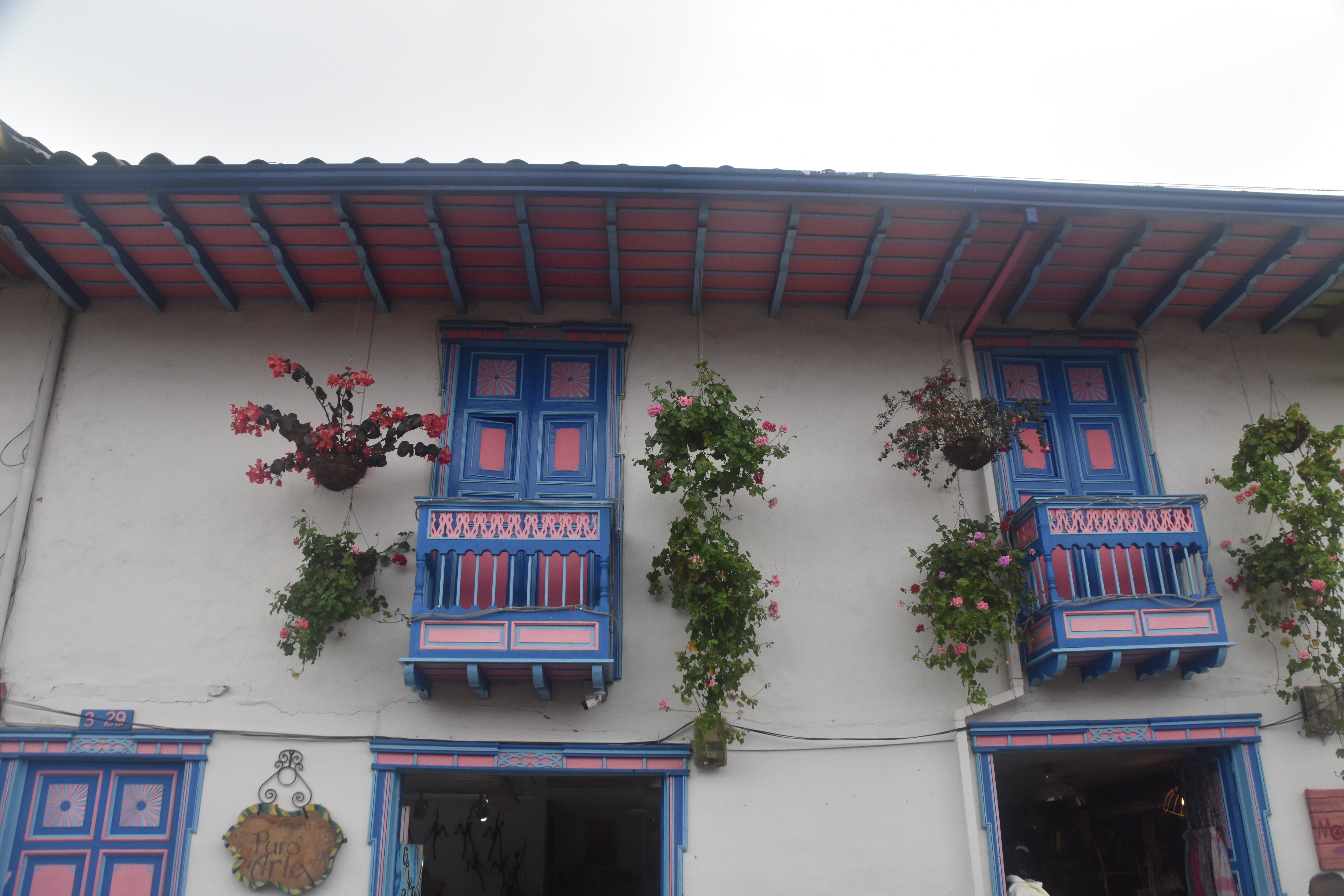
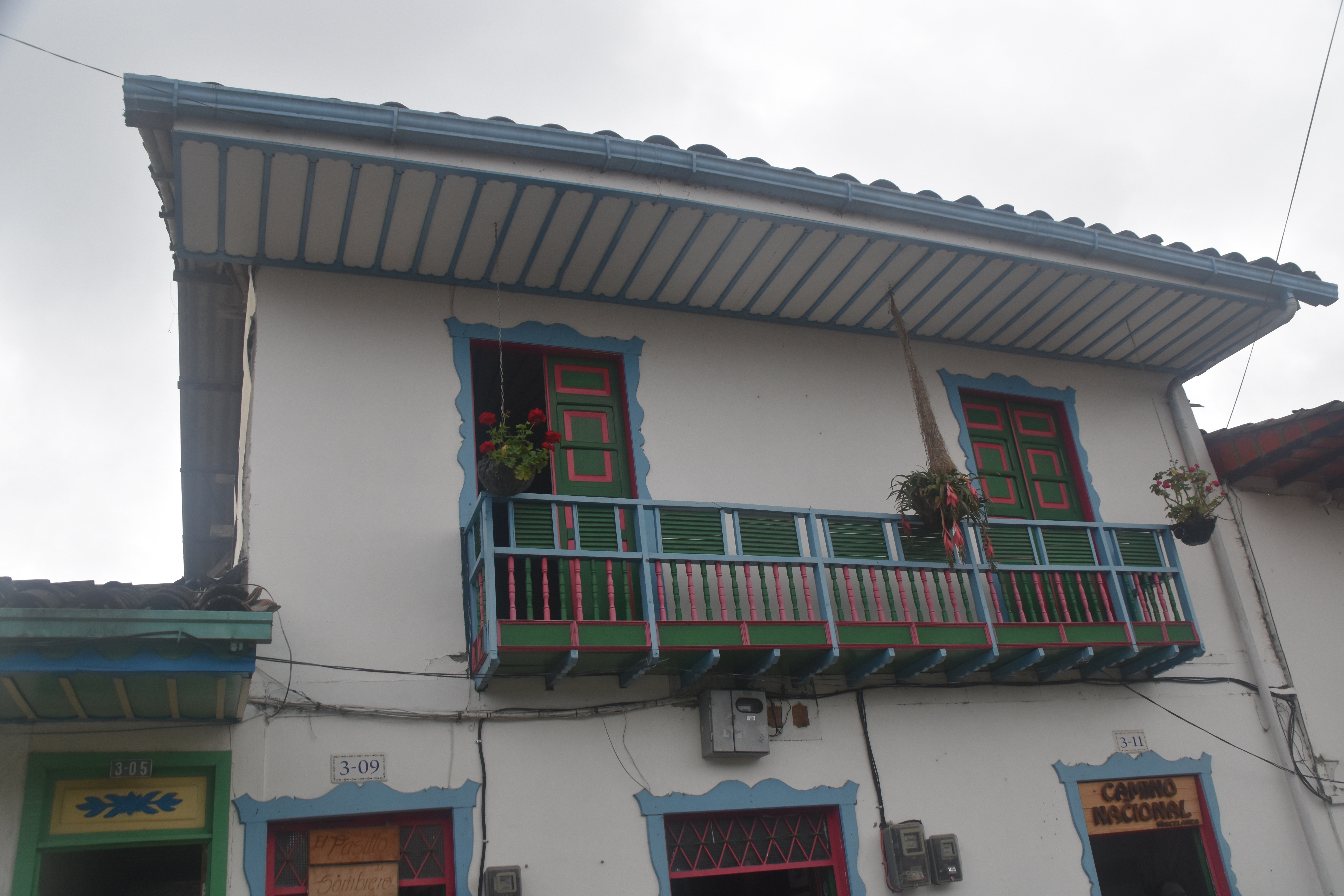
Notice in these last three photos that the downstairs doors are open. If you really want to get the best photos of Salento’s famous wooden buildings you need to return in the morning before the businesses open which Alison & I did the next day. Most of these photos were shot on her Samsung 8 smartphone.
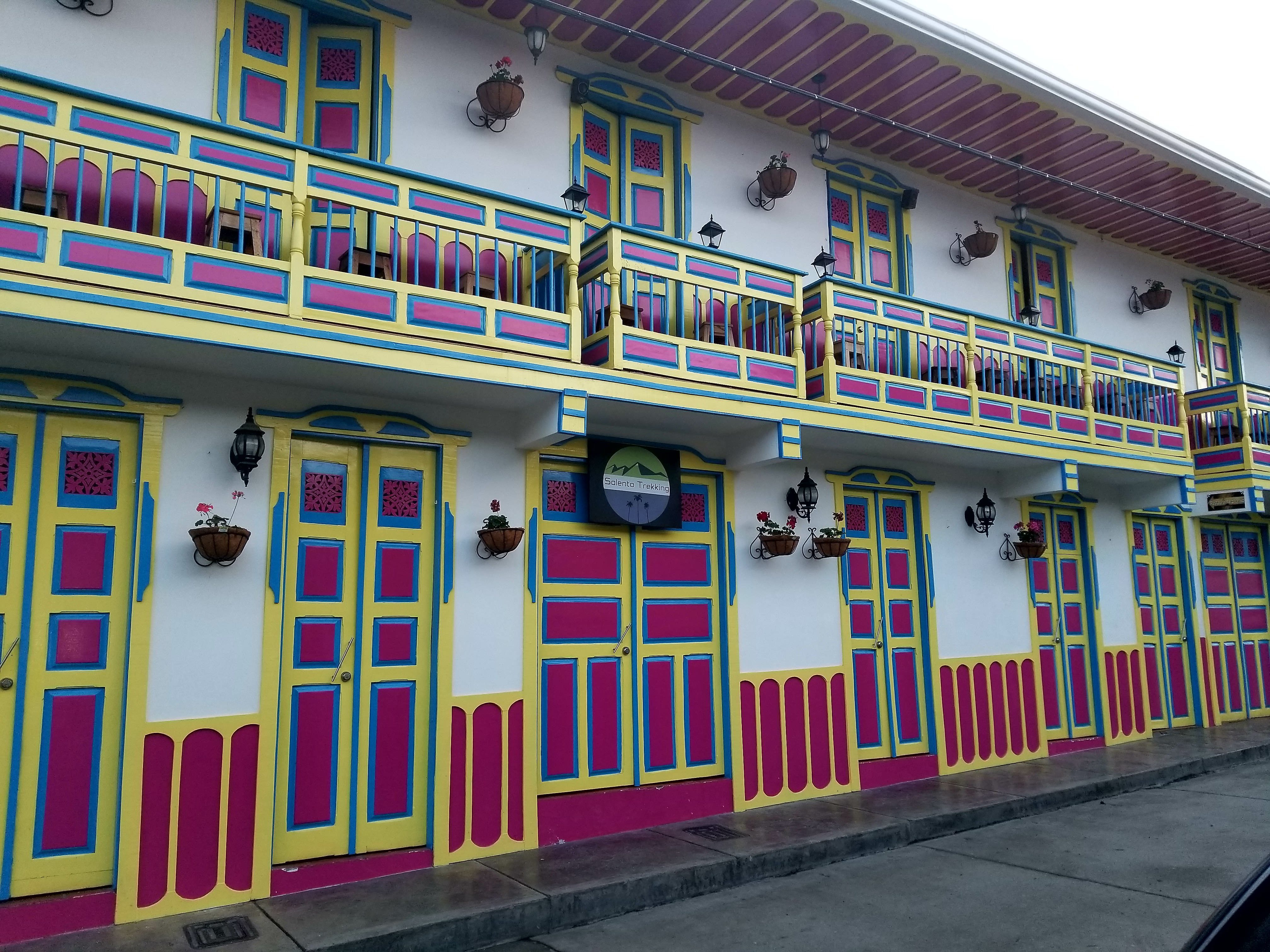
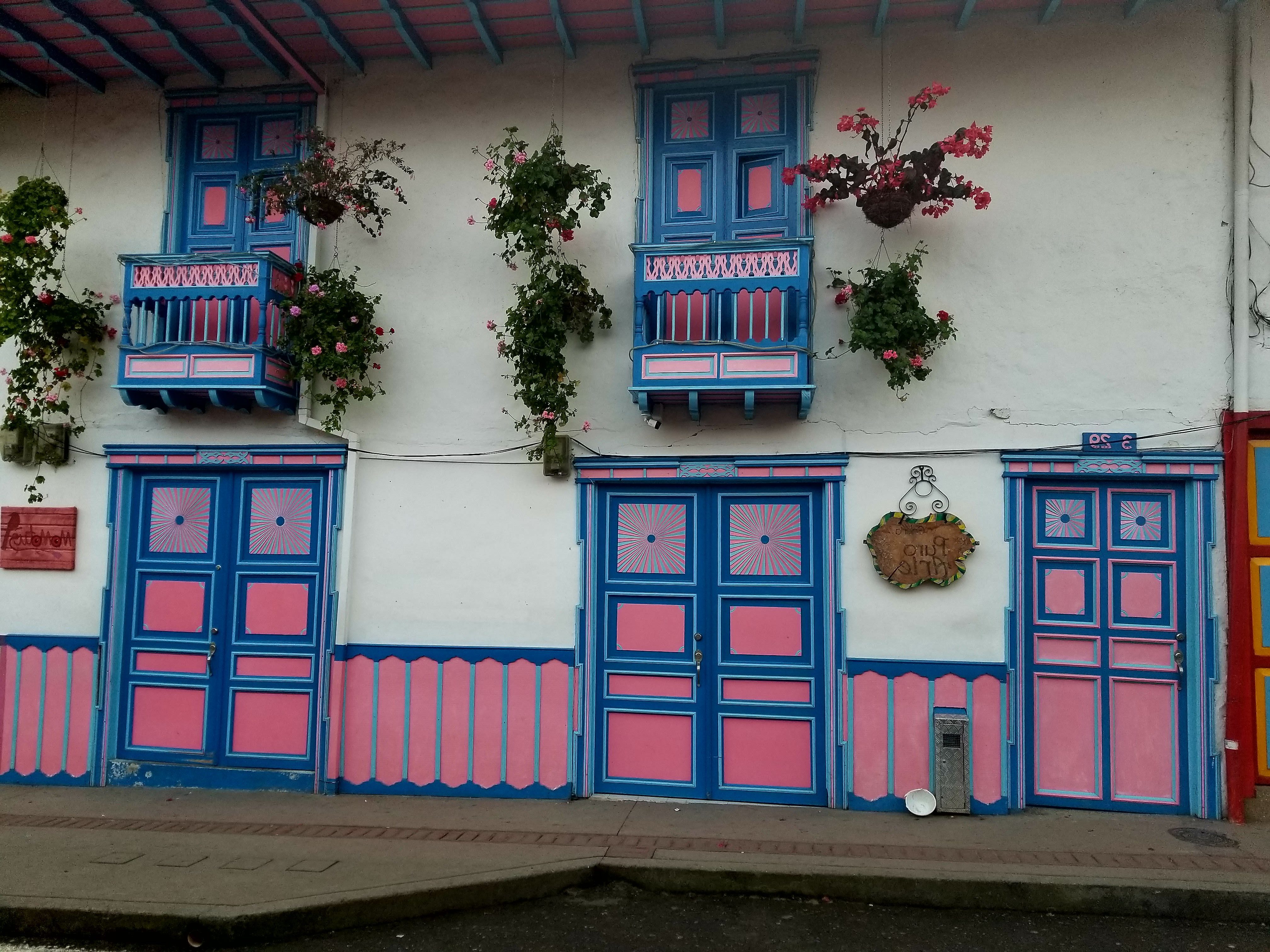
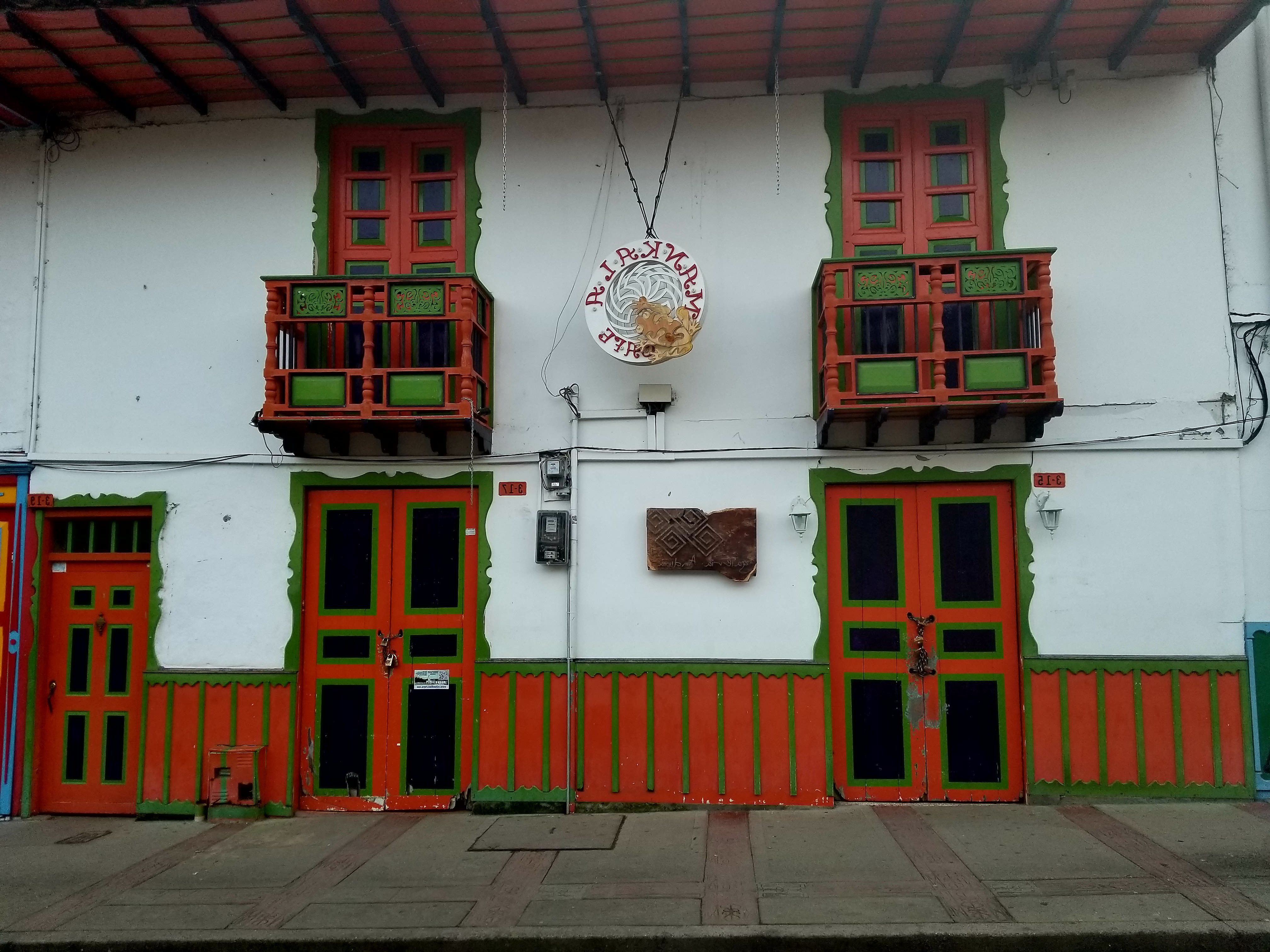
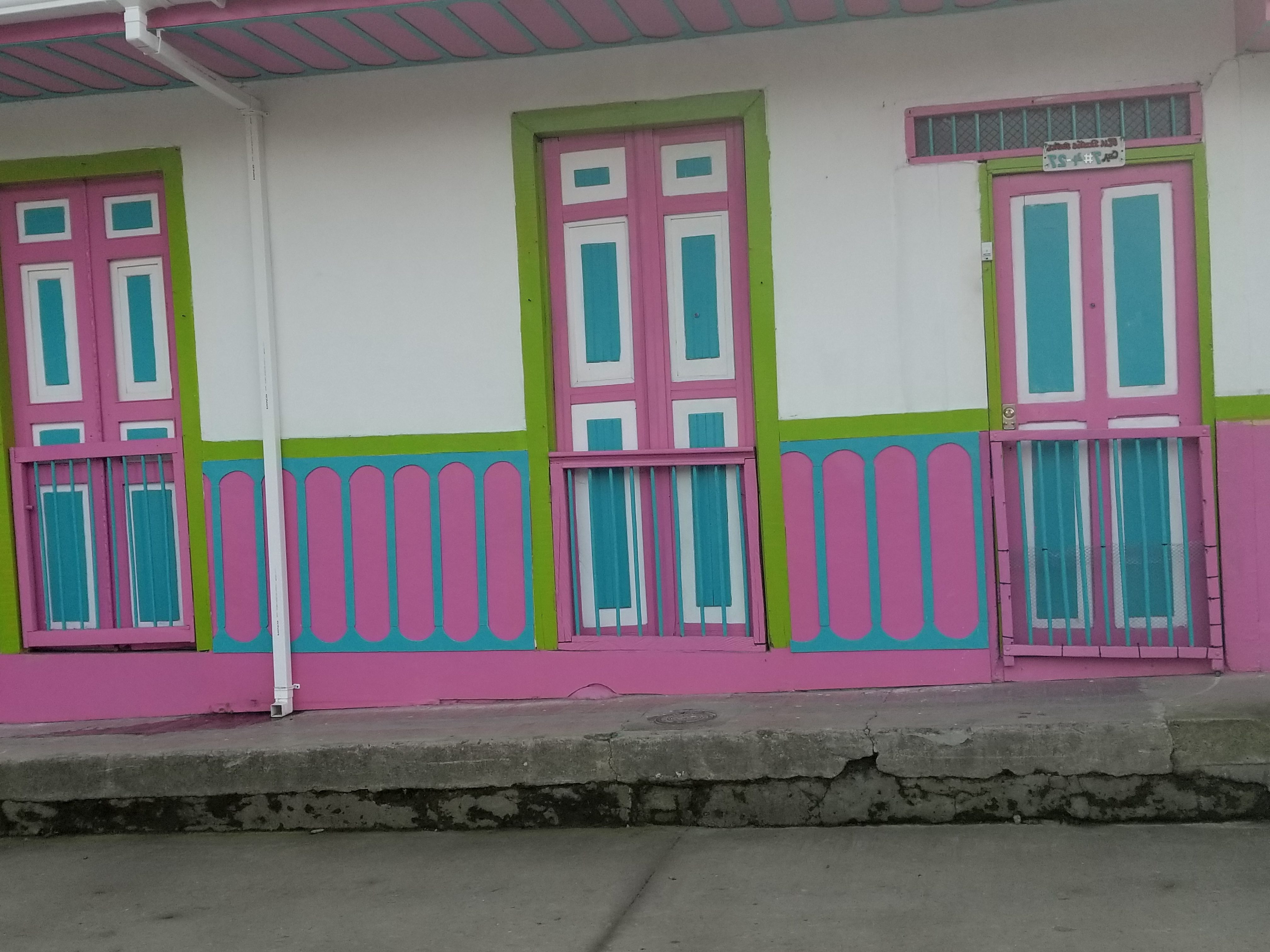
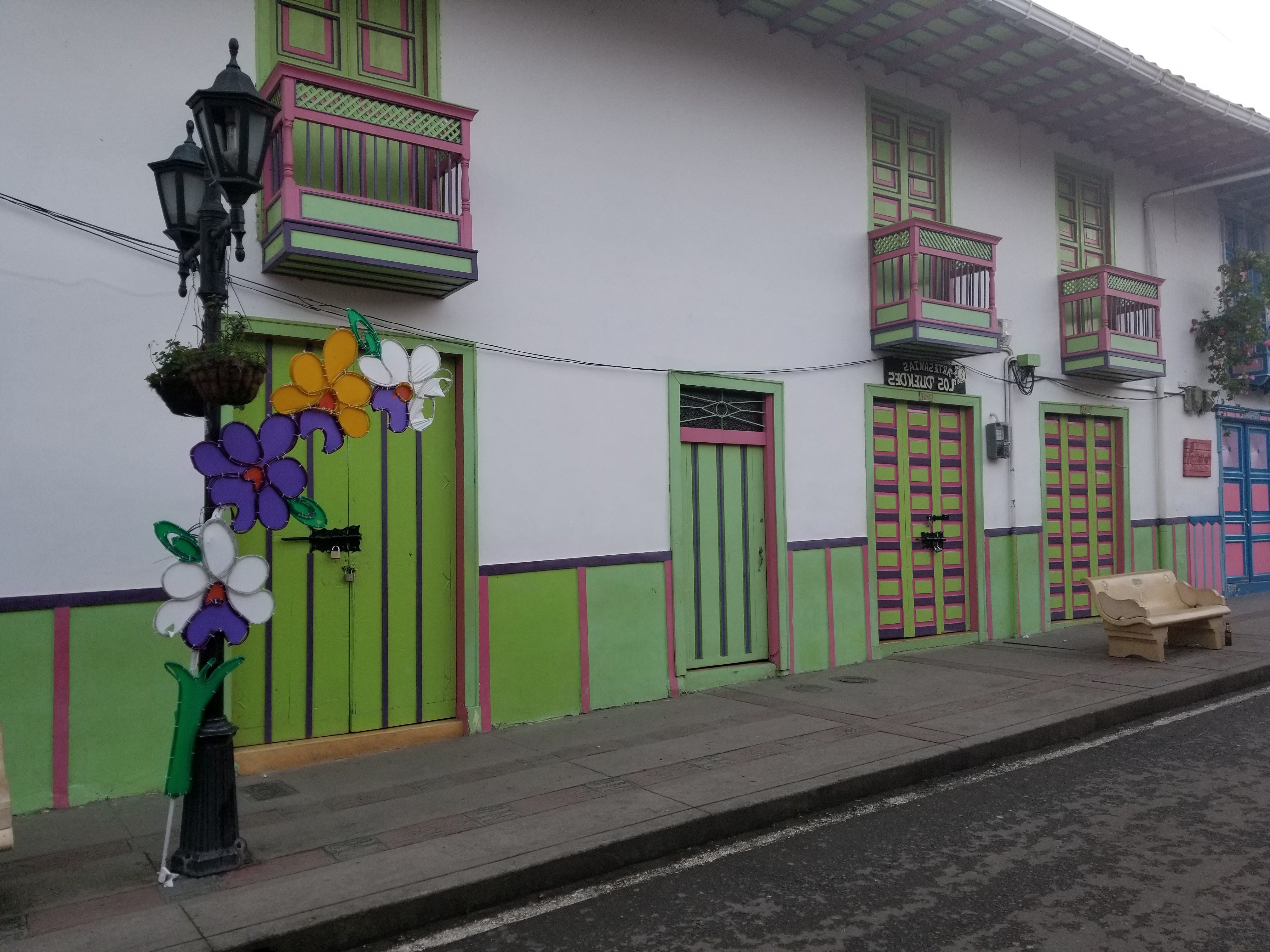
By now it was time for lunch and after eating at the airport in Armenia we weren’t famished, so we just ducked into a typical Colombian panaderia which is usually translated as a bakery, but is more a fresh bread shop. You can get a couple of right out of the oven pan de quesos and beers for a couple of bucks.
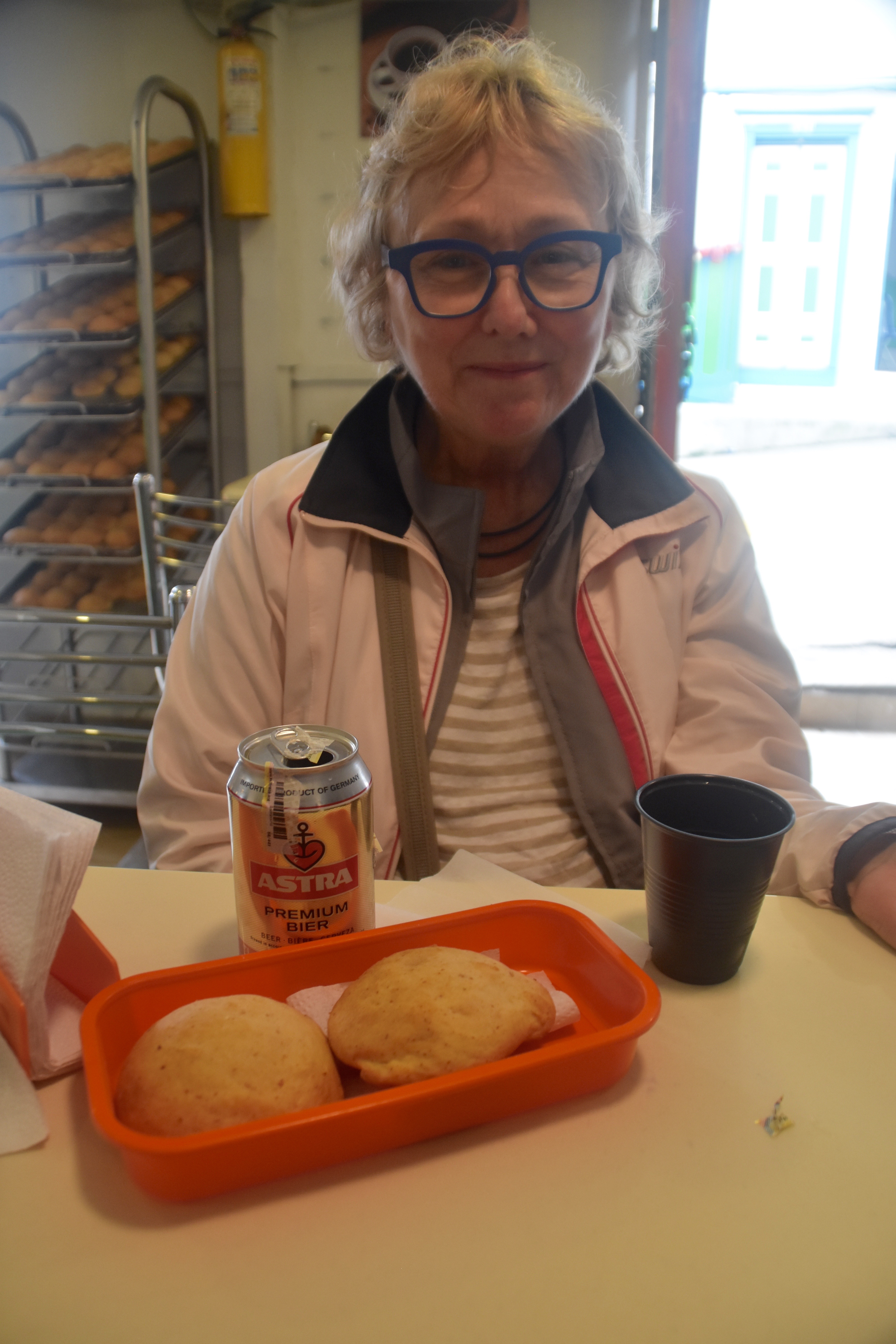
This place also had its own entertainment, as this version of Benji would come in off the street and go into his begging act until some sucker paid him off with a piece of bread. One guy bought him his own entire loaf which he vigorously defended against bigger dogs hoping to cash in on his luck. Benji was just about the only beggar we saw in Colombia, aside from the dog at Armenia airport. I run into at least a dozen just walking down Spring Garden Road in Halifax on any given day.
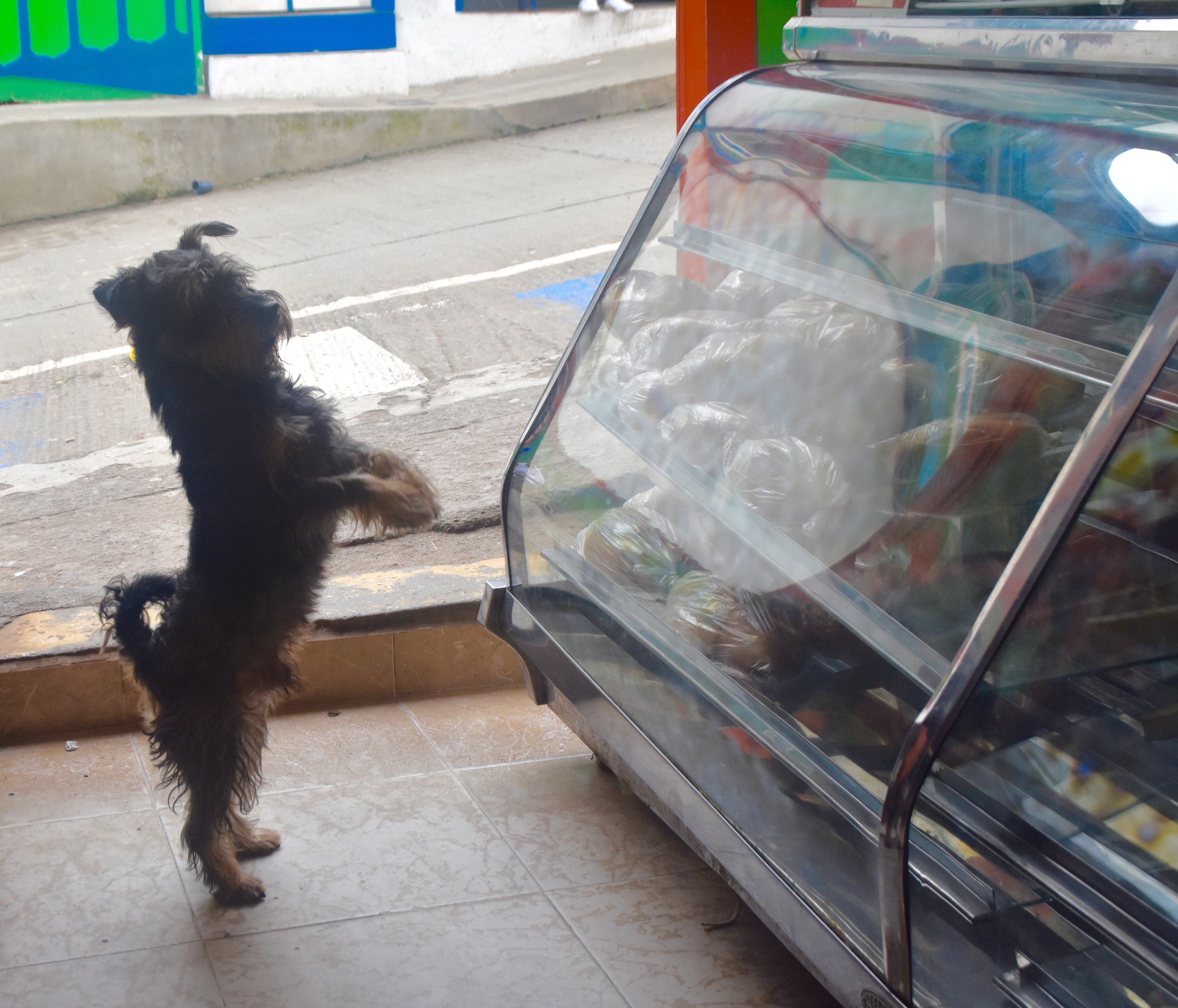
After lunch we are headed to the legendary coffee fields of Colombia which will be the subject of my next post. Hope you’ll join me as I say adios from Salento.

